Delve into the rich and diverse avian world of Idaho with our blog post on the 9 most common orange birds found in this state. Known for its awe-inspiring landscapes, from deep gorges to expansive lakes, Idaho is not just a hiker’s paradise but a haven for birdwatchers. The vivid splash of orange in the state’s bird population adds a remarkable touch to its natural charm.
Join us as we take a closer look at these colorful creatures, from the iconic American Robin to the unique Rufous Hummingbird. Packed with vibrant photos and intriguing details, this guide is sure to enrich your birdwatching experience in Idaho.
Orange Birds Found In Idaho
Idaho’s varied geography, from its high mountain ranges and sprawling forests to its lake-dotted valleys, provides a wide range of habitats that host a spectacular diversity of bird species, including a striking assortment of orange-plumaged wonders.
Barn Swallow

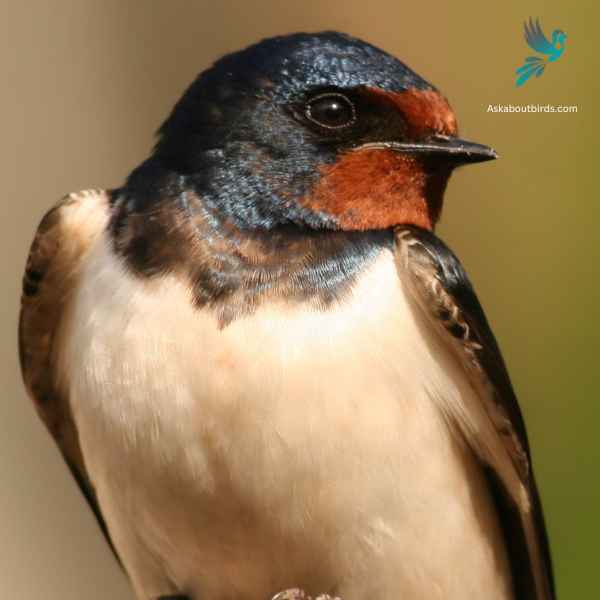
| Feature | Measurement |
|---|---|
| Scientific Name | Hirundo rustica |
| Length | 6.5–7.5 in |
| Wingspan | 12.5–13.5 in |
| Weight | 16–22 g |
The Barn Swallow is a sleek, agile bird renowned for its graceful flight patterns and iconic forked tail, often seen darting over fields and water bodies in search of flying insects.
Appearance: Barn Swallows have deep blue, almost iridescent, upperparts and a rufous to tawny underbelly. Their distinctively forked tail and long wings give them a streamlined look. Both males and females have a similar appearance, though males often exhibit slightly brighter colors and a deeper fork in the tail.
Diet: Barn Swallows feed primarily on flying insects, which they catch in mid-air during their agile and acrobatic flights. Their diet includes flies, beetles, moths, and other small flying insects.
Reproduction: Barn Swallows are known for building their mud nests on man-made structures, particularly barns, bridges, and eaves. The nest is cup-shaped and made from mud pellets, often lined with feathers. The female lays a clutch of 4 to 6 eggs.
American Robins


| Feature | Measurement |
|---|---|
| Scientific Name | Leptotila plumbeicep |
| Length | 10.6-11.8 in |
| Wingspan | — |
| Weight | 160-200 g |
The American Robin is a widely recognized bird species known for its melodious song and early bird tendencies.
Appearance: American Robins are medium-sized birds with a distinctive appearance. Both males and females sport a gray to brown back and a warm red to orange breast and belly and gray wings. They also have a characteristic white eye-ring and a black head, but males are usually darker than females.
Diet: American Robins have a diverse diet that changes depending on the season. In summer, they feed heavily on earthworms, beetles, and other invertebrates, which they catch on the ground. During winter, they mostly eat fruits and berries.
Reproduction: American Robins usually build their nests in trees or shrubs, but they are also known to nest on human-made structures. The female lays a clutch of about 3 to 5 eggs, which she incubates for about 12 to 14 days.
Bullock’s Oriole

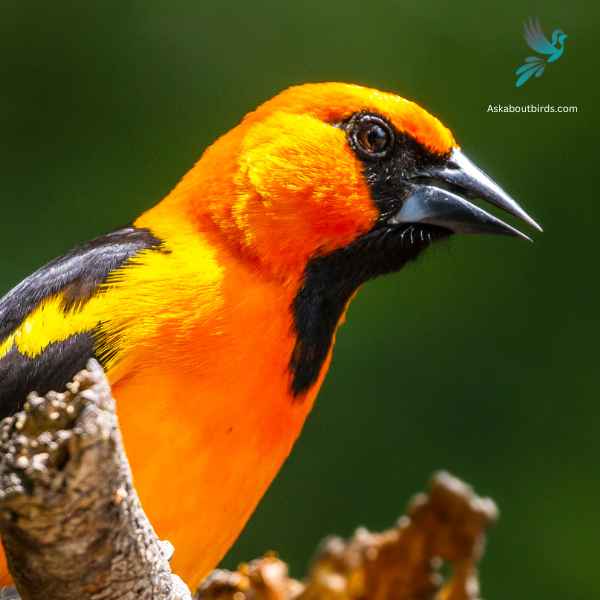
| Feature | Measurement (Imperial) |
|---|---|
| Scientific Name | Icterus bullockii |
| Length | 7.5-8.5 inches |
| Wingspan | 11.8-12.6 inches |
| Weight | 0.9-1.2 oz |
The Bullock’s Oriole is a bright and lively songbird, known for its stunning contrasting colors and vibrant melodies, predominantly found across the western regions of North America.
Appearance: The male Bullock’s Oriole boasts a brilliant orange chest, belly, and face with a black crown, eye line, throat, and back. Its wings are black with a prominent white patch and white-edged coverts. Females are more muted in coloration, displaying a yellowish-orange hue with grayish-brown wings that still retain the white patches.
Diet: These orioles primarily feed on insects, especially caterpillars, beetles, and grasshoppers. Apart from insects, their diet also includes fruits, berries, and nectar. They’re adept foragers, often hanging upside-down on branches to find hidden prey.
Reproduction: Bullock’s Orioles are noted for their skill in crafting hanging, woven nests, often positioned on the tips of slender branches, ensuring they are difficult for predators to access. Both parents partake in feeding the young, who then fledge about two weeks after hatching.
Red-breasted Nuthatch

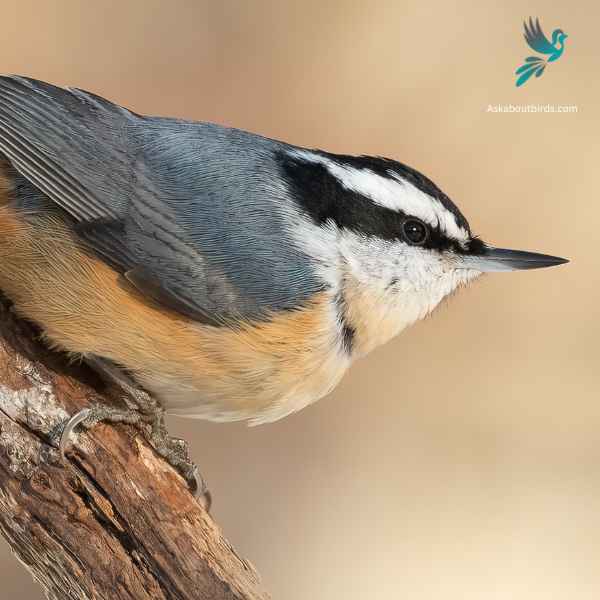
| Feature | Measurement |
|---|---|
| Scientific Name | Sitta canadensis |
| Length | 4.3–4.7 in |
| Wingspan | 8.3 in |
| Weight | 0.3–0.5 oz |
The Red-breasted Nuthatch is a small, agile songbird, known for its ability to move headfirst down tree trunks while searching for food.
Appearance: This bird boasts a slate-blue back and a pale rust-red underside. A prominent black stripe runs through the eye and is bordered above by a white eyebrow. Their sharp, pointed bill is characteristic of the species.
Diet: Red-breasted Nuthatches primarily feed on insects and seeds, especially those from coniferous trees. They have a fondness for large seeds, which they wedge into bark crevices to hack open with their bills.
Reproduction: These birds construct nests in natural tree cavities or abandoned woodpecker holes, often lining the entrance with resin. This is thought to deter predators or competitors from entering. The female typically lays a clutch of 5 to 6 eggs, and both parents partake in feeding the chicks once they hatch.
Eastern Towhee

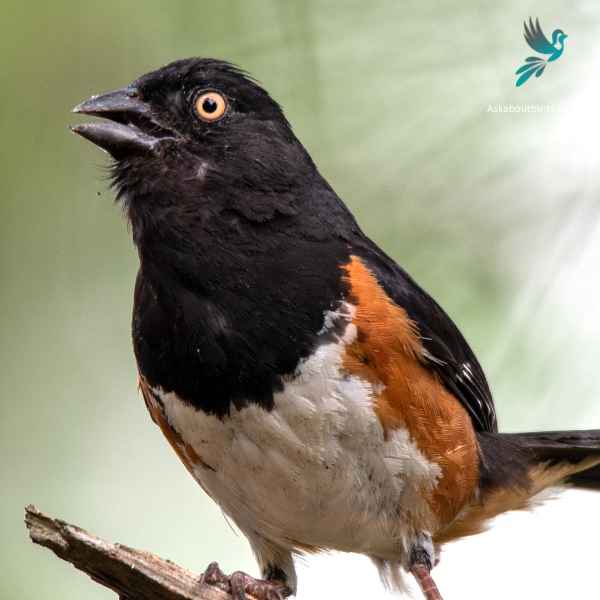
| Feature | Measurement |
|---|---|
| Scientific Name | Pipilo erythrophthalmus |
| Length | 6.8 to 9.1 in |
| Wingspan | 7.9–11.8 in |
| Weight | 32 to 53 g |
The Eastern Towhee is a distinctive songbird known for its unique calls and eye-catching coloration.
Appearance: Male Eastern Towhees are characterized by a striking combination of a black head, back and tail, contrasting with a white belly and rufous flanks. Females sport similar patterns but instead of black, they have a rich brown color. Both genders have red eyes, lending a special charm to their overall appearance.
Diet: Eastern Towhees primarily feed on a variety of insects, seeds, and berries. Their diet is quite diverse, taking advantage of seasonal offerings, which includes beetles, caterpillars, spiders, acorns, grass seeds, and various fruits and berries.
Reproduction: Eastern Towhees build their nests on or near the ground, often in a shrub or a small tree. The female lays around 3-5 eggs and takes the primary role in incubating them over about 12-13 days.
Spotted Towhee

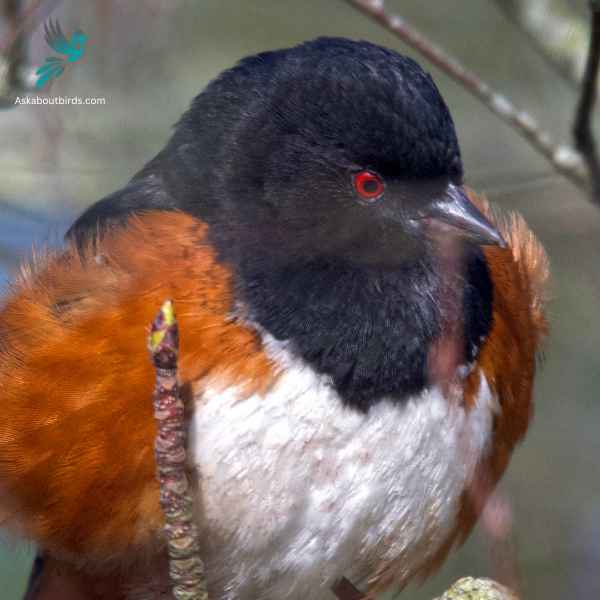
| Feature | Measurement |
|---|---|
| Scientific Name | Pipilo maculatus |
| Length | 6.7-8.3 in |
| Wingspan | 11.0 in |
| Weight | 33 g |
The Spotted Towhee is a distinctive songbird commonly found in the shrubby undergrowth and thickets of the western parts of North America. Its song, a series of melodious chirps, often punctuates the early morning air.
Appearance: Male Spotted Towhees showcase a coal-black head, throat, and upper body contrasted with rufous sides and a white belly. Their wings and back are dark but adorned with white spots, hence their name. Females have a similar pattern but are more brownish than black.
Diet: Spotted Towhees primarily feed on a mixture of insects and seeds. They often forage on the ground, scratching through leaf litter to uncover beetles, ants, and other insects, as well as various seeds and berries.
Reproduction: Spotted Towhees usually nest on the ground, concealed by dense vegetation or sometimes in low shrubs. The female builds the nest and lays a clutch of 3 to 5 eggs. She incubates the eggs, while the male stands guard and both parents partake in feeding the fledglings after hatching.
American Redstart


| Feature | Measurement |
|---|---|
| Scientific Name | Setophaga ruticilla |
| Length | 4.3 to 5.5 in |
| Wingspan | 6.3 to 9.1 in |
| Weight | 8.6 g |
The American Redstart is a lively warbler known for its vivid colors and active hunting style, often seen flitting about, fanning its tail to startle and catch insects.
Appearance: Adult male American Redstarts boast striking black plumage with bright orange patches on the sides, wings, and tail. Females and immature males have grayish-olive upperparts with yellow patches in the same areas where the males display orange.
Diet: American Redstarts are primarily insectivores. They actively forage for flying insects, as well as caterpillars and spiders, often using their colorful tails to startle prey and make them easier to catch.
Reproduction: The female American Redstart builds a cup-shaped nest in the fork of a tree branch. Typically, she lays a clutch of 3 to 5 eggs. The female takes on the primary responsibility of incubating the eggs, while both parents participate in feeding the fledglings after they hatch.
Varied Thrush
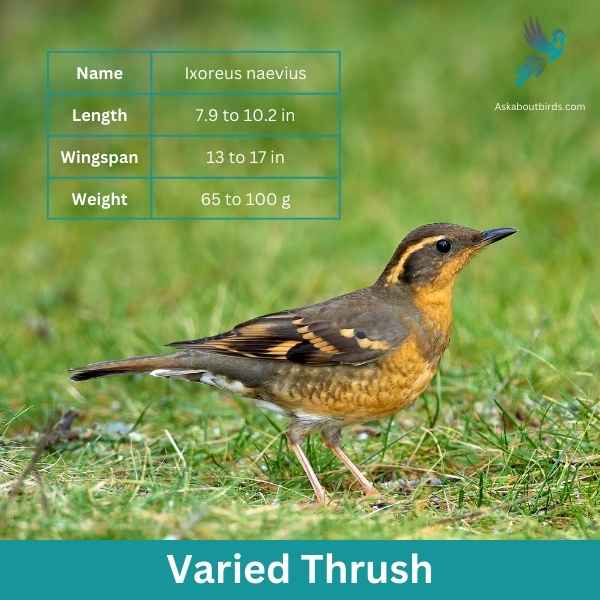

| Feature | Measurement |
|---|---|
| Scientific Name | Ixoreus naevius |
| Length | 7.9 to 10.2 in |
| Wingspan | 13 to 17 in |
| Weight | 65 to 100 g |
The Varied Thrush is a songbird known for its striking appearance and melodious, haunting song that echoes through the dense forests of the Pacific Northwest.
Appearance: The Varied Thrush has a bold pattern. Males display a blue-gray upper body, contrasted with an orange throat and breast, and a black band that extends from the eyes to the neck. The wings have two orange bands and the belly is usually lighter. Females have a similar pattern but are generally more muted in color.
Diet: Varied Thrushes primarily consume insects, berries, and seeds. Their diet can shift seasonally, with insects being more prevalent in the warmer months and berries and seeds making up the bulk of their diet in colder months.
Reproduction: Varied Thrushes nest in trees, often close to the trunk and concealed by dense branches or foliage. The female typically lays a clutch of 3 to 5 eggs, which she incubates.
Black-headed Grosbeak

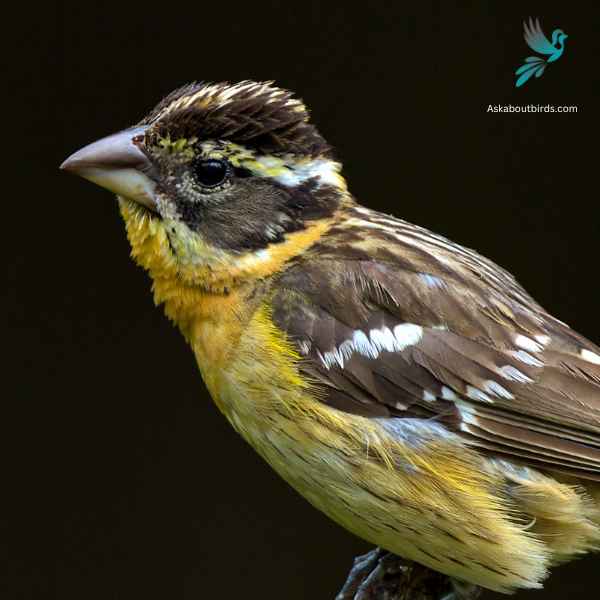
| Feature | Measurement |
|---|---|
| Scientific Name | Pheucticus melanocephalus |
| Length | 7.1–7.5 in |
| Wingspan | 12.6 in |
| Weight | 34–48 g |
The Black-headed Grosbeak is a vibrant songbird known for its melodious song, often confused with that of the American Robin but more rich and varied.
Appearance: Males are recognizable by their orange chest, black head, and black and white wings. Females, on the other hand, have a streaked brown appearance, resembling large sparrows but with hints of orange on their sides and flanks.
Diet: Black-headed Grosbeaks primarily feed on insects, seeds, and fruits. They are especially fond of beetles and caterpillars, and they’re one of the few birds that can eat monarch butterflies without suffering from the toxins.
Reproduction: They often nest in deciduous trees or shrubs. The nest is a loose, cup-like structure made from twigs and grasses. The female usually lays 3 to 4 eggs, which she incubates. Both parents share the responsibility of feeding the chicks.
Where to Spot Idaho’s Orange Birds
Whether you’re an experienced birder or a casual observer, these are the top locations you should explore for a glimpse of the state’s vibrant orange avian population:
- Coeur d’Alene Lake: Nestled in the northern part of Idaho, Coeur d’Alene Lake offers abundant birdwatching opportunities. The area around the lake and its adjacent forests is a fantastic spot to see Western Tanagers and Bullock’s Orioles.
- Bear Lake National Wildlife Refuge: This refuge is a haven for waterfowl and migratory birds. The mix of marshland and upland provides an ideal habitat for the colorful Northern Flicker.
- Boise River Greenbelt: This green oasis in the heart of Boise city offers an excellent urban birding experience. The American Robin is a common sight along the tree-lined path.
- Camas National Wildlife Refuge: Near the town of Hamer, this refuge hosts a variety of bird species due to its combination of wetlands, meadows, and sagebrush. The Rufous Hummingbird can be observed here during migration.
- Farragut State Park: With its diverse habitats of forests, grasslands, and water bodies, Farragut State Park in northern Idaho is a birder’s paradise. The park’s wide-ranging environments attract a plethora of species, including the eye-catching Black-headed Grosbeak.
| Neighboring State’s Orange Birds | Top Spots for Birdwatching |
|---|---|
| Montana’s Orange Birds | Lee Metcalf National Wildlife Refuge, National Bison Range, Glacier National Park |
| Wyoming’s Orange Birds | Grand Teton National Park, Yellowstone National Park, Seedskadee National Wildlife Refuge |
| Utah’s Orange Birds | Bear River Migratory Bird Refuge, Antelope Island State Park, Red Butte Garden and Arboretum |
| Nevada’s Orange Birds | Stillwater National Wildlife Refuge, Ash Meadows Wildlife Refuge, Ruby Mountains |
| Oregon’s Orange Birds | Malheur National Wildlife Refuge, Cape Meares State Scenic Viewpoint, Ridgefield National Wildlife Refuge |
| Washington’s Orange Birds | Ridgefield National Wildlife Refuge, Nisqually National Wildlife Refuge, Turnbull National Wildlife Refuge |
FAQs on Orange Bird Species Found in Idaho
What bird has an orange head in Idaho?
In Idaho, birds with orange plumage often capture attention. One bird with a prominent orange head is the Bullock’s Oriole. This bird boasts bright yellow to orange plumage complemented by black and white wings. Their vibrant colors make them a spectacle against the forest edges and open woodlands where they usually dwell. While these yellow birds predominantly consume insects, they occasionally visit bird feeders, especially those offering sunflower seeds. During the winter months, many of these winter birds migrate, but their presence in the warmer seasons is a delight to birdwatchers and enthusiasts.
What yellow birds are in Idaho?
In Idaho, several yellow birds grace the landscapes with their vibrant presence. The Western Meadowlark, with its bright yellow belly and distinctive black V on its chest, is a common sight in open fields and meadows. The Yellow Warbler, a small bird with an entirely yellow body, can be found in riparian areas, especially during the breeding season. The American Goldfinch, another yellow bird, can often be spotted in backyards, especially near bird feeders where they favor sunflower seeds. Western tanagers, known for their black wings, the cedar waxwing with dark gray wings has a faun or yellow body, Black headed grosbeaks can be yellowish as well.





